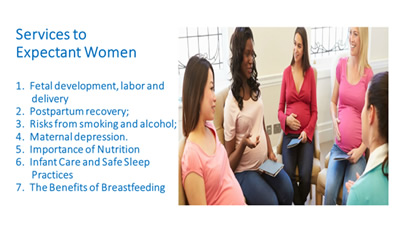Early Head Start
What Does Early Head Start (EHS) Look Like At MAP?- Services are provided for expectant mothers, infants and toddlers. EHS operates 48 weeks including 200 school days Monday through Friday five days per week
- Operation hours are determined by the needs of the parents and may vary across the agency.
- Eight children per classroom and the teacher child ratio is one Child Care Provider (CCP) to 4 children (1:4).
- Practice continuity of care (the infant/toddler remains with his/her Child Care Provider throughout EHS enrollment)
- Weekly anecdotal observations are conducted and documented by the Child Care Provider
- Screening begins to determine the child’s developmental level:
- Developmental: Battelle Developmental Inventory, II
- Mental Health: Ages & Stages Social-Emotional Questionnaire, 2nd Edition (CCPs and Parents)
- Hearing, Vision, Speech/Language and Growth Assessment
- Developmental Assessment: Learning Accomplishment Profile Birth – Kindergarten (LAP:B-K)
- Dental Services are expected to be completed within the first 90 days of entry into EHS.
- ON-GOING - All infants and toddlers enrolled in EHS must maintain their well-baby visits. These visits are scheduled as following: 1 month; 2 months; 3 months; 4 months; 6 months; 9 months; 12 months; 15 months; 18 months; 24 months; and 30 months.
- Lead test for infant/toddler 12 and 24 month
- Child Care Providers implement the Creative Curriculum for Infants, Toddlers and Twos 3rd Edition to provide indoor and outdoor learning activities.
- Other Curriculum Resources include: Infant & Toddler Planning Guide; Creating Environments & Curriculum for Infants and Toddlers: Connecting the Pieces
- Child Care Provider and other staff provide responsive care, effective teaching, and an organized learning environment that promotes healthy development and children’s skill growth aligned with the Head Start Learning Outcomes Framework.
- On-going observations and developmental assessment take place daily.
- Health and Safety practices are observed, through hygiene routines, feedings, cleaning, sanitizing, etc.
Screening and assessment provide valuable information about each child's interests, strengths, and needs. Screening
 gives a snapshot of whether the child's development is on track.
gives a snapshot of whether the child's development is on track.Assessment is an ongoing process that includes observation and provides information about development over time. Systematic, ongoing child assessment provides information on children's development and learning. It helps us inform curriculum planning, teaching, and individualizing for each child across all Head Start Early Learning Outcomes Framework domains.
The Child Care Providers regularly use assessment data along with informal teacher observations and additional information from family and staff, as relevant, to determine a child’s strengths and needs. The data is also used to inform and adjust teaching strategies and practices in the classroom. Activities from the assessment are shared with parents to implement and reinforce learning at home.
Prenatal and postpartum information, education, and services, 45 CFR §1302.81
Family partnership services for enrolled pregnant women, 45 CFR §1302.82
1. Within 30 days of enrollment, the Family Community Worker must determine whether each enrolled pregnant woman
 has an ongoing source of continuous, accessible health care – provided by a health care professional that maintains her ongoing health record.
has an ongoing source of continuous, accessible health care – provided by a health care professional that maintains her ongoing health record. 2. The Family Community will ensure that the expectant mother has insurance coverage.
3. If the expectant mother does not have a health insurance coverage or a source of ongoing care; then as soon as possible the Family Community must facilitate her access to a source of care that will meet her needs.
4. The Family Community Worker may provide access to comprehensive services through referrals that include nutritional counseling, food assistance, oral health care, mental health services, substance abuse prevention and treatment and emergency shelter or transitional housing in cases of domestic violence.
5. The curriculum utilized for expectant mothers is Partners for A Health Baby.
6. A newborn visit with each mother and baby must be conducted within two weeks after the infant’s birth. The purpose of the visit is to offer support and identify family needs.
Copyright | MAP, Inc., All Rights Reserved | OHS Disclaimer